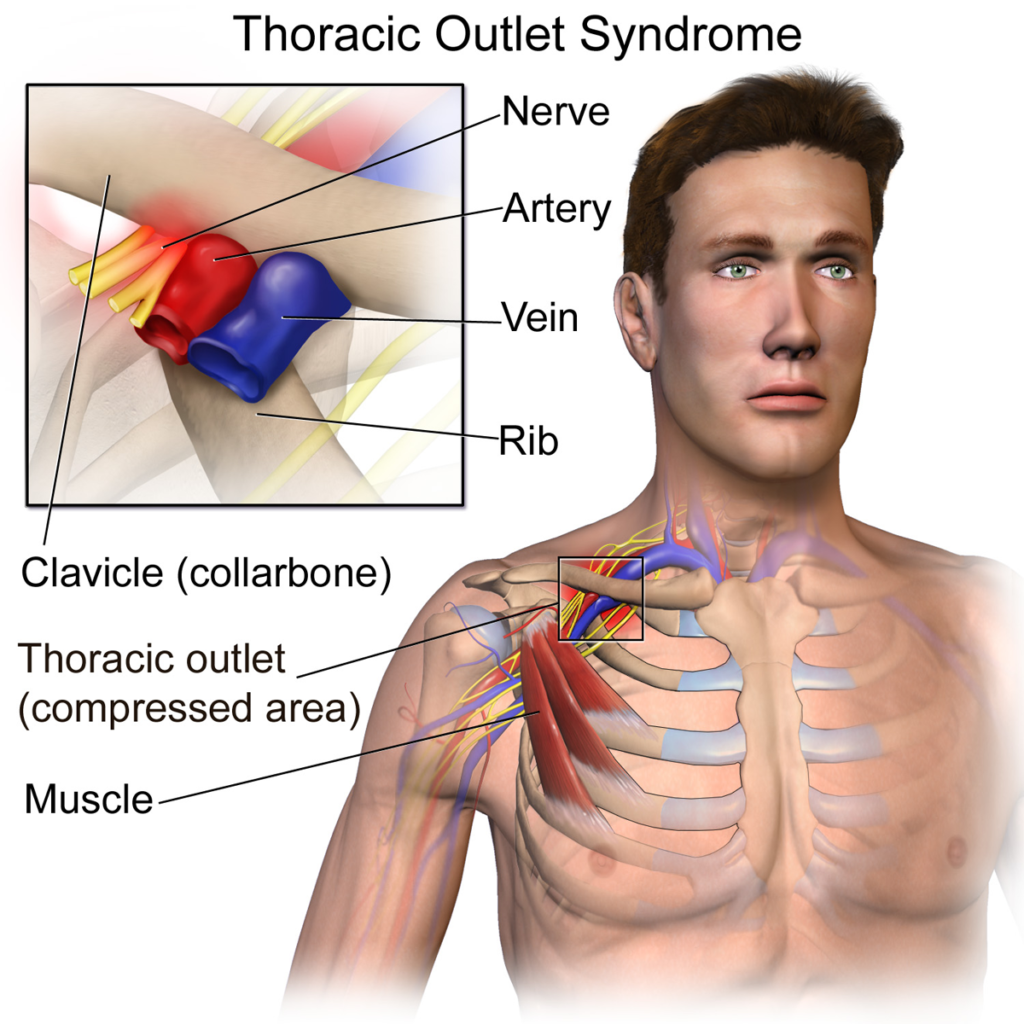Thoracic outlet syndrome (TOS) is a medical condition that involves the compression of the nerves or blood vessels in the thoracic outlet region of the body. This can cause a range of symptoms, including pain, numbness, and tingling sensations in the shoulder, arm, and hand. One of the most common triggers for TOS is sleeping in an improper position, which can exacerbate the compression and lead to severe discomfort. As such, finding the right sleeping position for TOS sufferers is crucial for managing this condition.

In this blog post, we will explore the thoracic outlet syndrome sleeping position tips that can help manage TOS symptoms and alleviate discomfort. We will delve into the various factors that can contribute to TOS, including posture and sleeping position. We will also provide tips and tricks on how to adjust your sleeping position to reduce the pressure on the thoracic outlet region. With our guidance, TOS sufferers can sleep soundly and wake up feeling refreshed without having to face the discomfort and pain associated
1. What is Thoracic Outlet Syndrome?
Thoracic outlet syndrome is a condition that occurs when nerves or blood vessels in the space between the collarbone and first rib are compressed or pinched. Symptoms of thoracic outlet syndrome can include pain, weakness and numbness in the neck, shoulder, arm or hand. There are various types of thoracic outlet syndrome, including neurogenic, venous, and arterial. Neurogenic is the most common type, accounting for approximately 95% of cases and is caused by compression of the brachial plexus nerves. This condition can be due to an anatomical abnormality or an injury, such as a fall or car accident. Poor posture and sleeping positions may also contribute to the development of thoracic outlet syndrome. Therefore, it is recommended to sleep in a position that does not place added pressure on the neck, shoulders or arms. Anyone experiencing symptoms of thoracic outlet syndrome should seek medical attention to determine the underlying cause and appropriate treatment.
2. What are the symptoms of Thoracic Outlet Syndrome?

Thoracic Outlet Syndrome (TOS) is a condition that is caused by the compression of nerves and blood vessels that pass from the neck to the upper limbs through the thoracic outlet. TOS is classified into three types depending on the location of the impingement. The symptoms of thoracic outlet syndrome are primarily neurological, affecting the strength and sensation of the arm and hand. The type and severity of symptoms depend on the type of thoracic outlet syndrome. The most common cause of thoracic outlet syndrome is the inadequate space in the thoracic outlet due to anatomic abnormalities, postural defects, or trauma. The diagnosis of thoracic outlet syndrome is made through a combination of patient history, physical examination, and diagnostic imaging tests. Early diagnosis and intervention are paramount to prevent the progression of TOS. Sleeping position may be a cause of thoracic outlet syndrome, as pressure on the thoracic outlet can exacerbate symptoms in some cases.
3. What is the cause of Thoracic Outlet Syndrome?
Thoracic Outlet Syndrome (TOS) is a condition that can cause significant discomfort and pain in the upper body, particularly the shoulder and arm regions. Symptoms of thoracic outlet syndrome can vary depending on the type of TOS, with symptoms ranging from numbness and tingling sensations in the fingers, to muscle wasting in the hand. The type of TOS detected also plays a significant role in determining the cause of thoracic outlet syndrome. Neurogenic TOS is caused by pressure on the brachial plexus nerves of the thoracic outlet, while vascular TOS is caused by the constriction of the blood vessels that supply the arm which affect blood flow. Cases of thoracic outlet syndrome can be indicative of a range of underlying conditions, such as repetitive strain injuries (RSI), whiplash, and pregnancy. However, sleeping positions that involve the upper arms being pinned behind the body can be a causative factor, as they can lead to nerve compression and constriction of the blood vessels. Identifying and avoiding harmful sleeping positions can aid in managing and preventing thoracic outlet syndrome.
4. What are the types of Thoracic Outlet Syndrome?
Thoracic Outlet Syndrome (TOS) is a medical condition characterized by the compression of the nerves, arteries, or veins in the upper chest area. The symptoms of TOS can vary depending on the location and severity of the compression. The most common symptoms of thoracic outlet syndrome include pain in the neck, shoulder, and arm, numbness or tingling sensation in the hand and fingers, and weakened grip strength. There are three types of TOS, namely Neurogenic TOS, Arterial TOS, and Venous TOS. Neurogenic TOS is the most prevalent type and is associated with nerve compression. Arterial TOS is caused by the compression of the subclavian artery, while Venous TOS is linked to compression in the subclavian vein. The primary cause of TOS is the compression of the nerves and vessels within the thoracic outlet. There are several cases of thoracic outlet syndrome related to poor sleeping positions that put pressure on the nerves and vessels in your upper chest area.
5. Example of cases of Thoracic Outlet Syndrome.
Thoracic Outlet Syndrome is a condition characterized by the compression of nerves and blood vessels in the space between the collarbone and the first rib. The symptoms of Thoracic Outlet Syndrome can vary significantly based on the type of the condition and the specific nerves that are impacted. There are three main types of Thoracic Outlet Syndrome, namely neurogenic, venous, and arterial. The cause of Thoracic Outlet Syndrome can be attributed to several factors, including muscle and bone anomalies, trauma, repetitive activities, anatomical predisposition, and congenital disorders. The condition is also associated with certain sleeping positions, such as sleeping with hands above the head or sleeping on one’s side. There are several cases of Thoracic Outlet Syndrome reported among individuals, including athletes, painters, assembly line workers, and office workers who regularly use computers or perform repetitive overhead work. Proper diagnosis and treatment of Thoracic Outlet Syndrome are crucial to alleviate the symptoms and improve the quality of life of affected individuals.
6. What is the best sleeping position for Thoracic Outlet Syndrome?
Thoracic Outlet Syndrome (TOS) is a condition that affects the nerves and blood vessels that pass through the thoracic outlet, which is located between the collarbone and the first rib. This disorder can cause a number of symptoms, including pain, cramping, numbness, tingling, and weakness in the arm and hand. The type of TOS a patient is suffering from and its cause, are important considerations in determining the best sleeping position for the patient. The symptoms of thoracic outlet syndrome can be aggravated or alleviated by certain sleeping positions. For instance, if the patient experiences symptoms of neurogenic TOS, they may benefit from sleeping on their back with a thin pillow to avoid compressing their brachial plexus. However, if the patient has venous TOS, sleeping with the affected arm elevated can help reduce their symptoms in the case of side sleepers or those doing a fetal position. Ultimately, as with any medical condition, patients with TOS should consult their healthcare provider to determine the best sleeping position based on their unique case.
A. Place a pillow under the shoulders for support
B. Place a pillow between the knees to support the spine
C. Avoid sleeping on the stomach
D. Opt for a side sleeping position
E. Ensure the neck and head are aligned
F. Consider sleeping with the arms above the head
G. Place a pillow under the arms for additional support
H. Place a small pillow between the chest and bed for further support
7. How to treat Thoracic Outlet Syndrome?
Thoracic Outlet Syndrome (TOS) is a medical condition that typically occurs in the upper extremity region. The onset of symptoms of thoracic outlet syndrome can be gradual, such as weakness or numbness in the fingers, pain in the shoulder muscles, or neck pain in the neck muscles. It is important to understand that there are three types of thoracic outlet syndrome: neurogenic, vascular, and nonspecific. The most common type is neurogenic, which affects the nerves, followed by vascular which affects the blood vessels which may result into blood clots. It has been found that poor posture and repetitive arm and shoulder movements contribute to the cause of thoracic outlet syndrome. So it is important to maintain a good posture. Any kind of injury or trauma to the area can also lead to cases of thoracic outlet syndrome. Treatment for the condition depends on the type and severity of the syndrome. Treatment options include physical therapy by a physical therapist, occupational therapy, medications, and in severe cases, surgical treatment. Sleeping position can also have an impact on the symptoms of thoracic outlet syndrome, it is advisable to avoid sleeping on the stomach and opt for a side-sleeping position with the affected arm supported with a pillow.
8. What social support do people with Thoracic Outlet Syndrome need?
When it comes to managing Thoracic Outlet Syndrome (TOS), social support plays a crucial role in enhancing physical and emotional well-being. Individuals with TOS experience a range of symptoms such as pain, numbness, weakness, and tingling in the arms, shoulders, and neck. Due to the nature of the condition, individuals with TOS may require different types of social support at different stages of their recovery process. The type of TOS an individual has, such as neurogenic, arterial, or venous, may also influence the type of social support needed. Moreover, the cause of Thoracic Outlet Syndrome, which can range from repetitive strain injuries to trauma, can impact the severity of symptoms and the extent of social support needed. Therefore, it is essential to understand the particular cases of Thoracic Outlet Syndrome and social support needs of individuals with TOS to provide effective support in managing this condition. Some types of social support that might be beneficial include emotional support, practical support, informational support, and peer support groups. Additionally, educating family and friends about the symptoms of TOS and the importance of proper sleeping positions can help improve the quality of life for individuals with TOS.
9. The emotional impact of Thoracic Outlet Syndrome.
Thoracic outlet syndrome (TOS) can have a profound emotional impact on those who suffer from it. The symptoms of thoracic outlet syndrome, such as pain, numbness, and tingling in the arm, neck, and shoulder, can severely limit a person’s ability to carry out daily activities. This can lead to frustration, depression, and anxiety, as the person struggles to maintain normalcy in their life. Additionally, the type of thoracic outlet syndrome a person has can impact their emotions. Neurogenic TOS, for example, which is caused by compression of the nerves in the shoulder region, can cause pain and weakness that worsens with activity. This can lead to feelings of sadness and hopelessness as the person struggles with the limitations the condition imposes upon them. The cause of thoracic outlet syndrome can also play a role in a person’s emotional well-being. Cases of thoracic outlet syndrome that are caused by trauma, such as a car accident or repetitive strain injury, can elicit feelings of anger or frustration, while cases that are caused by anatomical abnormalities may lead to feelings of sadness or despair. It is important for those who suffer from TOS to seek support from loved ones, medical professionals, and mental health specialists to
10. What the future holds for people with Thoracic Outlet Syndrome?
In terms of the future for people with Thoracic Outlet Syndrome (TOS), it largely depends on the type and severity of the condition. TOS is known for causing a wide range of symptoms, such as pain, numbness, and weakness in the arm and hand, which can make it difficult to sleep comfortably. Some individuals may find relief from certain sleeping positions, while others may require more comprehensive treatment. The three main types of TOS – neurogenic, arterial, and venous – have different causes and treatment approaches. Neurogenic TOS stems from compression of the brachial plexus nerves, while arterial and venous TOS result from compression of the subclavian artery and vein, respectively. In some cases, TOS is caused by trauma or anatomic abnormalities. Fortunately, with proper diagnosis and treatment, most people with TOS can manage their symptoms effectively and continue to live active and fulfilling lives.
In conclusion, finding the right sleeping position for thoracic outlet syndrome can be a game-changer for those who suffer from the condition. It is essential to avoid positions that cause excess pressure on the neck, shoulder, and arms. Instead, try to keep your arms supported and close to the body while sleeping on your back. Alternatively, sleeping on your side with a supportive pillow can also be effective. If you are struggling with thoracic outlet syndrome, experimenting with different sleeping positions may provide the relief you need to get a good night’s sleep. However, it’s always a good idea to consult with a healthcare professional for personalized recommendations.



